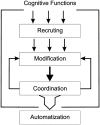Reading as functional coordination: not recycling but a novel synthesis
- PMID: 25309489
- PMCID: PMC4176034
- DOI: 10.3389/fpsyg.2014.01046
Reading as functional coordination: not recycling but a novel synthesis
Abstract
The Functional Coordination approach describes the processes involved in learning to read as a form of procedural learning in which pre-existing skills, mainly from the visual, and auditory domain, are (1) recruited, (2) modified, and (3) coordinated to create the procedures for reading text, which form the basis of subsequent (4) automatization. In this context, we discuss evidence relating to the emerging prevalence of analytic processing in letter perception. We argue that the process of learning to read does not have to lead to a loss of perceptual skill as consequence of a "cultural recycling"; learning to read just leads to a novel synthesis of functions, which are coordinated for reading and then automatized as a package over several years. Developmental dyslexia is explained within this framework as a Functional Coordination Deficit (Lachmann, 2002), since the coordination level is assumed to be most liable to manifest deficiencies. This is because, at this level, the greatest degree of fine tuning of complex functions is required. Thus, developmental dyslexia is not seen as a consequence of a deficient automatization per se, but of automatization of abnormally developed functional coordination.
Keywords: analytic vs. holistic processing; child development; congruence effect; developmental dyslexia; literacy; reading acquisition; visual processing.
Figures





References
-
- Ackermann H., Hertrich I. (2000). The contribution of the cerebellum to speech processing. J. Neurolinguistics 13 95–116 10.1016/S0911-6044(00)00006-3 - DOI
LinkOut - more resources
Full Text Sources
Other Literature Sources

